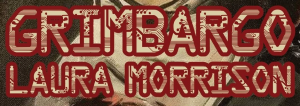
‘Jackie’s theory was that a lot of deep thought was the result of pondering death and the meaning of life, and that post-Greywash there was just no urgency anymore to explore those topics, so people just shoved those musings to the back of their brains to rot.’ – Jackie (Laura Morrison, Grimbargo)
Grimbargo is a sci-fi thriller murder-mystery in a world without death. I mean, mostly without death. You see, there’s been one of those: A death. For the first time in over a decade.
Weird, right? Could you imagine what would happen if nobody could die? For years? Years upon years? Well, Laura Morrison does just that. In fact, it’s the core premise that drives this book and many of its characters’ actions. The Greywash, a worldwide nanotech event, has rendered everyone immortal.
As Jackie points out above, the lack of mortality changes things in a world that no longer fears time. Injuries, even death, are just healed away. However, Grimbargo focuses on the aftermath rather than the event itself. Throughout society, people have fallen into a stagnant philosophical pond of meaninglessness. It’s only been a decade, but culture is already starting to get weird. Groups form to test different methods of suicide. The religious struggle to figure out which apocalypse happened to who. Killing a bad driver is almost acceptable. Eating, breathing, and sleeping become frivolous luxury.
Yet this is just background. The world is set, described, and put in motion within the first dozen pages. Plot gallops forward after that friendly hello with world building. One thing is clear from the start, this book will not be boring. Setting, characters, and plot weave together in a frantic rush toward secret plans and frantic escapes. The wild-ride of Saturday-Morning doomsdays pays enough attention to reality to toy with fantastical ideas, but the story lets fun triumph over hard-science. After enough twists, turns, and deaths to paint a maze red with blood, Laura Morrison leads readers to a satisfying ending of farce sprinkled with depth.
Characters
Jackie Savage, on a reporting job, is doing a fluff piece on how people feel about the anniversary of the Greywash. She’s a sarcastic sort, and starts with a glib air toward her fellow undying. Jackie shows herself to be sarcastic, stubborn, brave, and impulsive with a core of distrust and fear of losing control. Most of her actions seem driven by rejecting greater responsibility, and throughout the story she seems to struggle with sincerity to avoid self-reflection. Jackie’s arc consists of accepting a place in larger schemes and surrendering to events outside of her control.

Docent Jamie Nguyen is introduced giving a tour inside the Women’s Institute of Sciences and Technology (WIST). Risk-averse and rules-minded, Jamie develops as a strong opposite to Jackie’s flippancy while maintaining strength in self-confidence and logic. She lived with WIST her entire life and indoctrination shows in her actions and mannerisms. Pleasantly, Jamie gets a breath of freedom as the story progresses which leads to entertaining fish-out-water moments along with lovely long-term growth. There’s a solid arc leading from timidity toward authority figures to the sensible questioning of even the most well-regarded leaders.
Readers meet most of the cast within a few dozen pages at a more-than-manageable pace. Each of the characters stand-out without having to wonder who they were. The important individuals certainly stick in the mind. Morrison crafts voices that are comfortably distinct per person. However, only the main villain, Lady Airth, is truly unique in tone. She felt like the strongest presence throughout the book. Others, such as suicide-club leader Trigger or WIST conspirator Lady Morse, seem diminished by unfulfilled potential. A reoccurring element of the characters is that they are nearly entirely defined by their actions. Though a strong element of character development, it leads to well-defined individuals only if they have time on-page. The less-seen characters might have benefited from an extra jolt of additional sensory elements.
Plot
The recipe for Grimbargo is not going to take anyone by surprise. Two ordinary folks are caught in a murder mystery that reveals a worldwide conspiracy. However, the roads that lead from start to finish are fun and the scenery is pleasant. The driver, Morrison, enjoys taking both shortcuts and the scenic route. She routinely throws characters into awkward absurdity at their expense but lets that absurdity lead to a splendid cold-storage location for medical samples. Many similar moments were happy detours into silliness and lighthearted philosophical ranting.
Yes, sometimes the plot took a break and got a drink in a bar down in some back-alley locals’ place. At one point, this results in a hilarious discussion about cold-blooded animals that does little to progress the story. But, as stated before, the author seems more intent on having fun and enjoying the journey. It’s refreshing to see characters that are almost stupidly human. Some might find frustration in some of the roundabout developments, but the very nature of the characters being “average” is that they were unlikely to take the most direct route. The result is a surprisingly relatable series of decisions in an insane world.
A ready suspension-of-disbelief is going to be helpful for this story, but there isn’t anything that stands out as an egregious error in the chain-of-events. Some of the character motivations, such as Jackie’s willingness to overcome painful risks, could be strengthened. Still, there’s enough in her characterization to suppose the reasons why. Key conflicts, like a certain plane ride and the departure of the scene’s antagonists, would also have been helped with some tweaking of the deus ex machinery. However, the rationale and understanding are comfortably available without straining through mental gymnastics. The plot is solid and follows genre-honored rules of action and overcoming danger. Morrison’s execution of many moments, such as the main antagonist’s final departure, are grin-inducingly amusing twists of fate.
Overall
Grimbargo is an entertaining action-adventure-mystery that’s hilarious and bright despite some rather dark elements. The characters are either likable or understandable enough to empathize with their plight whether supposedly evil or not. The plot is quick and clear without being boring or predictable. Everything fits in this world, and there are hints of depth behind the sarcastic banter and witty snark. The core ideas, that of death and bodily-autonomy, are great foundational ideas to ponder and work well within a vehicle of immortality through nanobots. There’s scenes and ideas and imagery that are sure to be entertaining for conversations. All-in-all, Morrison provides a delightful escapist sci-fi story of colorful characters that’s easy to read.
Four Stars!
Get it here: Purchase on Amazon
Published by SpaceBoy Books
The Author: Laura Morrison
Clarity and Readability – ![]()
Originality and Interest – ![]()
Cohesiveness and Setting – ![]()
Characters and Development – ![]()
Enjoyability – ![]()
*Note: A digital Advance Reader Copy (ARC) was provided to facilitate this review.
– J.A.